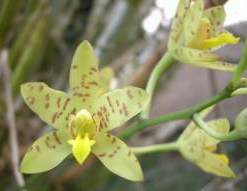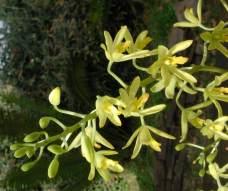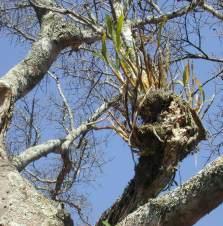Ansellia africana
Ansellia africana Lindl.
Family: Orchidaceae
Common names: leopard orchid (Eng.); luiperdorgidee (Afr.); imfeyenkawu(Zulu)
Introduction
This is the largest of our epiphytic orchids and grows in spectacular clumps in trees in the subtropical areas of southern Africa.
 © Martin von Flintel
© Martin von Flintel
Description
Description
This orchid is an epiphyte, which means that the whole plant, roots and all, grow above ground, attached to the branches of trees. The roots, which anchor the plant to the tree, are specially adapted to absorb water and nutrients very quickly. An unusual feature are the needle-like roots pointing upwards which form in a dense mass around the pseudobulbs and catch the rotting leaves and detritus upon which the plant feeds.
The plant flowers during the dry winter months in a mass of yellow or greenish yellow blooms, which can be lightly or heavily marked with brown spots. In the wild, plants live for a long time and can become very large, some estimated to weigh over a tonne.

Distribution and habitat
Distribution description
Distribution It is found in tropical Africa and into N Namibia, N Botswana, Swaziland, and in South Africa in the Northern Province, the Lowveld and Kwa-Zulu/Natal, mainly in the hot, dry river valleys.

Derivation of name and historical aspects
History
The plant was named after John Ansell, an assistant botanist on an 1841 expedition to the Niger River. In South Africa we have only the one species.
Ecology
Ecology
Hawk moths visit the very sweetly scented flowers at night and a pair of eagle owls were seen nesting in a huge clump of Ansellia africana in the hutted camp at Ndumu Game Reserve. The roots of this species are especially adapted to ensure its survival as an epiphyte.
Uses
Use
Traditionally, Ansellia africana is used as a love charm, as an antidote for bad dreams and at homesteads to ward off lightning. It is also much in demand as a specimen plant in gardens.

Growing Ansellia africana
Grow
This is a plant for that specimen tree in the garden. Because it will grow into a very large plant, it is best wedged into a fork or secured onto a large branch. It is important that the plant does not move about until new roots have secured it to the tree. This could take up to two years depending on growing conditions.
During summer the plant should be watered regularly allowing it to dry out between watering. Once new roots have formed, the occasional application of plant food will speed up growth and improve flowering. During the winter months the plant should be kept dry to allow the canes to harden off and for flower buds to be initiated. It will also grow in pots provided that coarse bark is used as a growing medium. Although this is a subtropical plant, it will survive occasional mild frost.
References
- Batten, A. & Bokelmann, H. 1966. Wild flowers of the eastern Cape Province. Cape & Transvaal Printers, Cape Town.
- Jackson, W.P.U. 1987. Origins and derivations of names of South African plant genera. University of Cape Town.
- Leistner, O.A. (ed.). 2000. Seed plants of southern Africa: families and genera. Strelitzia 10. National Botanical Institute, Pretoria. Nichols, G. 2002. Indigenous Plant of the Month. The Grapevine October 2002:76 Pooley, E. 1998. A field guide to wild flowers of KwaZulu-Natal and the eastern region. Natal Flora Publications Trust, Durban. Stewart, J., Linder, H.P., Schelpe, E.A. & Hall, A.V. 1982. Wild orchids of South Africa. Macmillan, Cape Town.
Credits
Brian Tarr
Natal National Botanic Garden
November 2003
Plant Attributes:
Plant Type: Epiphyte, Orchid
SA Distribution: KwaZulu-Natal, Limpopo, Mpumalanga
Soil type:
Flowering season: Winter
PH: Acid, Neutral
Flower colour: Brown, Yellow
Aspect: Full Sun, Morning Sun (Semi Shade), Afternoon Sun (Semi Shade)
Gardening skill: Average
Special Features:
Horticultural zones









Rate this article
Article well written and informative
Rate this plant
Is this an interesting plant?
Login to add your Comment
Back to topNot registered yet? Click here to register.